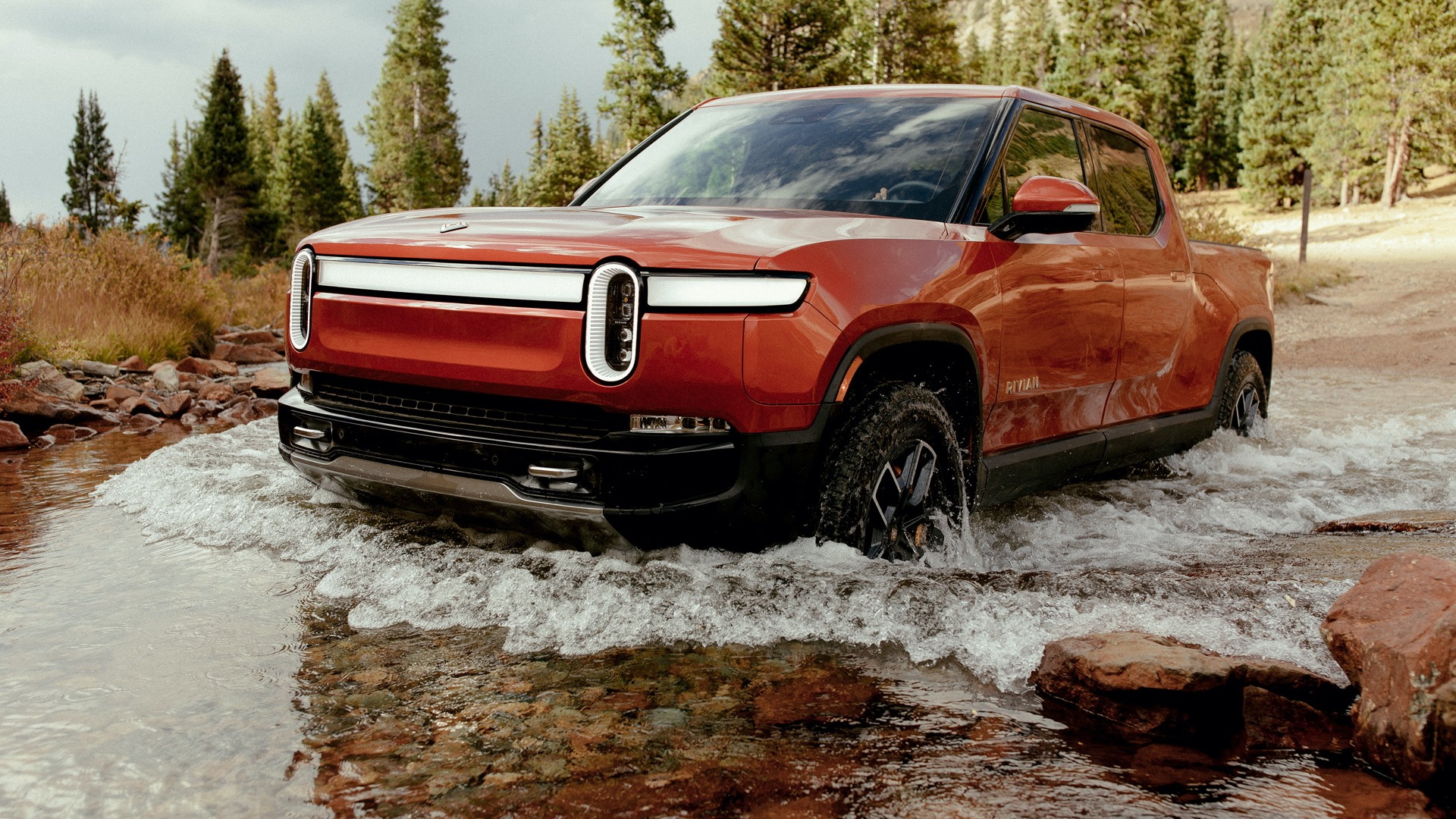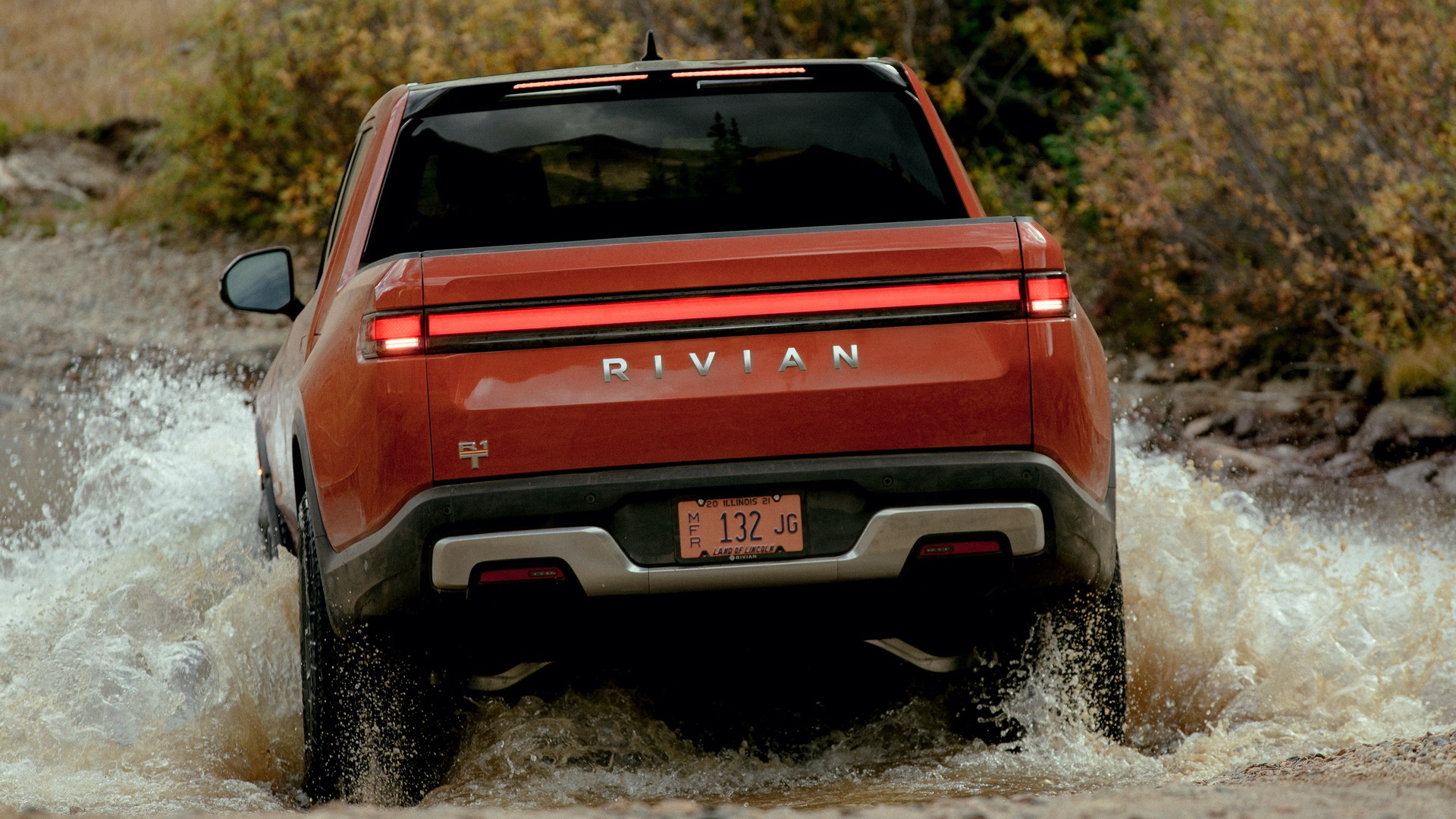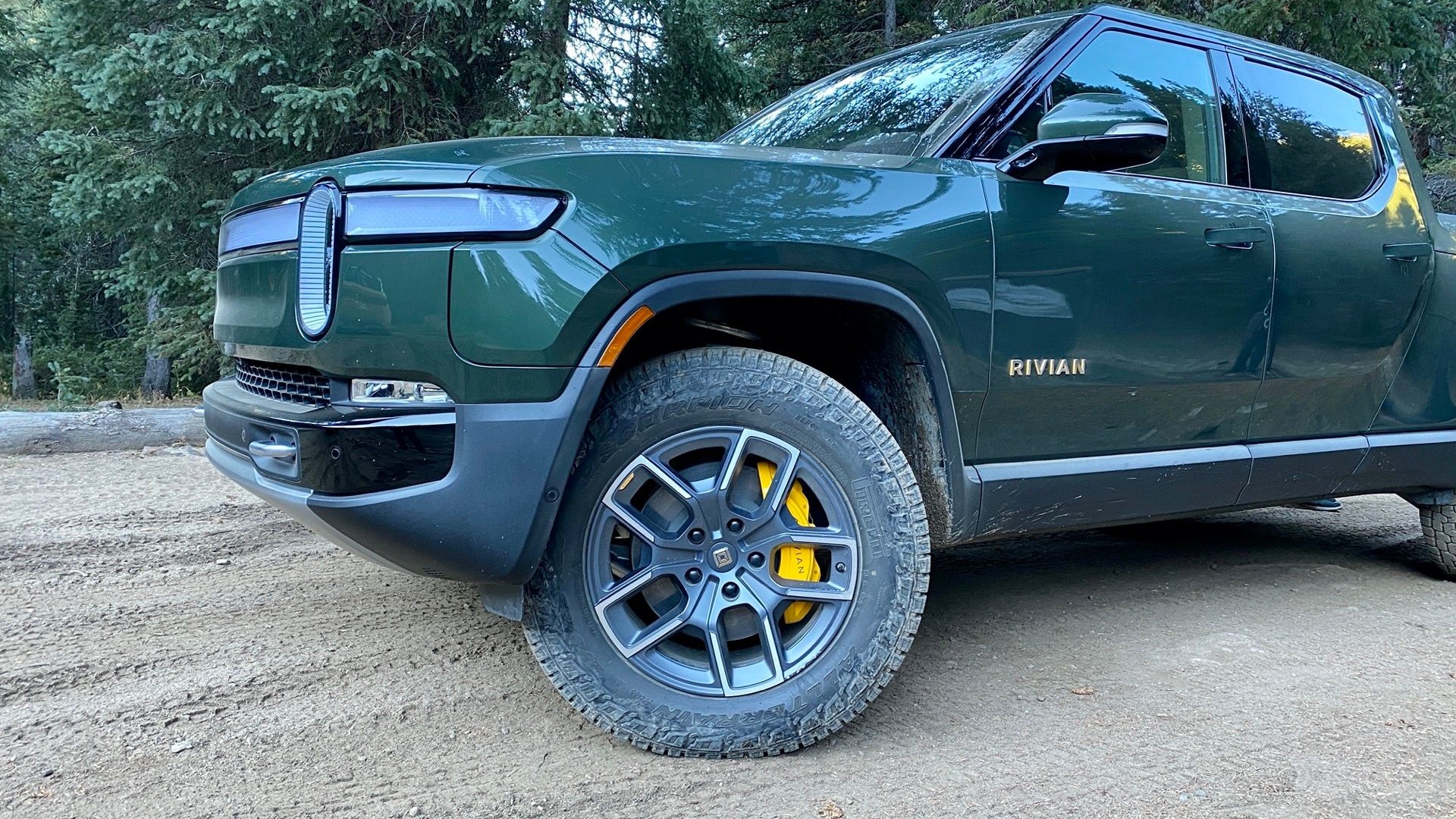The burbling of a nearby creek. The whisper of wind in the leaves. Aside from the crush of rock under tires, these are not the sounds typically heard from inside a typical off-road vehicle. The 2022 Rivian R1T electric pickup truck is anything but typical, and when it’s on pavement firing from 0-60 mph in 3.0 seconds, another sound fills the cabin: howls of joy.
The first vehicle from the American electric car maker is also the first electric pickup truck to market, beating out the forthcoming 2022 GMC Hummer EV and 2022 Ford F-150 Lightning, not to mention the Tesla Cybertruck chimera.
Sized between a full-size and mid-size pickup, the R1T’s performance dynamics, 11,000-lb towing capacity, lack of tailpipe emissions, cutting-edge technology, clever cargo utility, and adventuring accessories usher in the next era of what the classic American pickup truck can be.
Behind the wheel of a 2022 R1T Launch Edition with the Off-road package, I climbed up to 12,000 feet on a deeply rutted path to the Rocky Mountain ridges above Breckenridge, Colorado. To get there, I wound up and down twisty mountain roads with 6% grades, runaway truck ramps, and sheer shoulder drop-offs. Between its uncompromising off-road capability and its peerless pickup truck performance on pavement, the R1T is the most versatile vehicle I’ve ever driven.
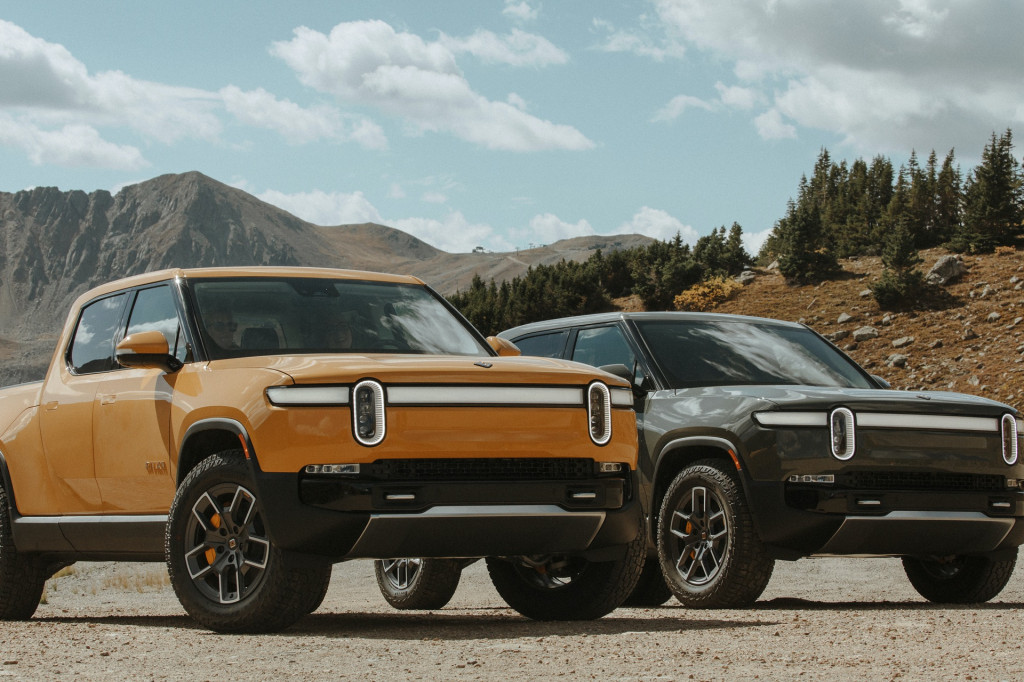
2022 Rivian R1T
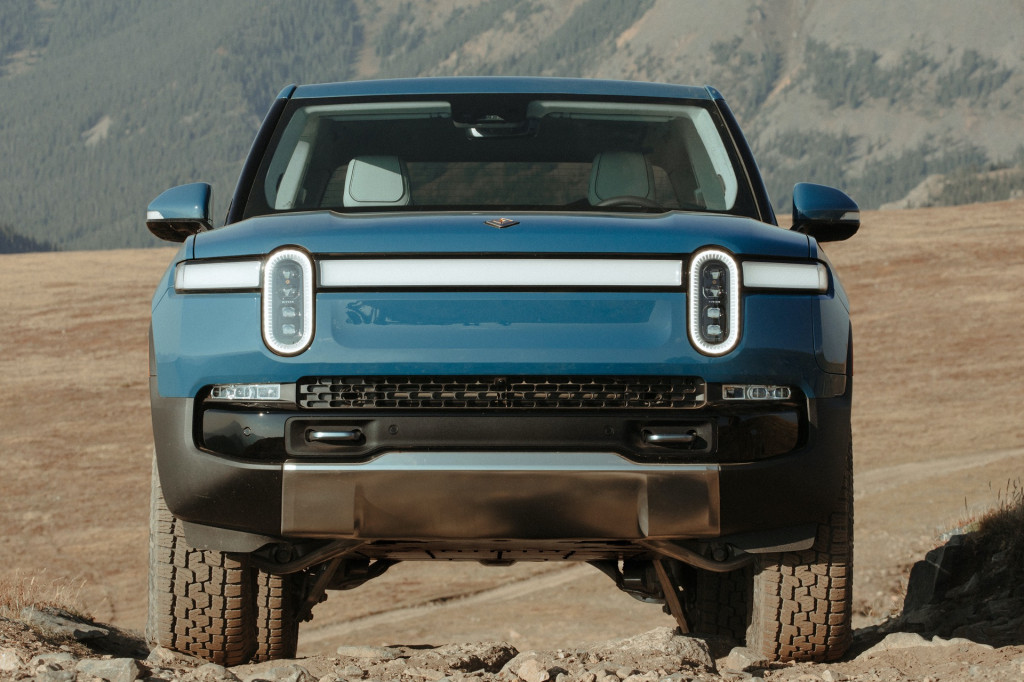
2022 Rivian R1T
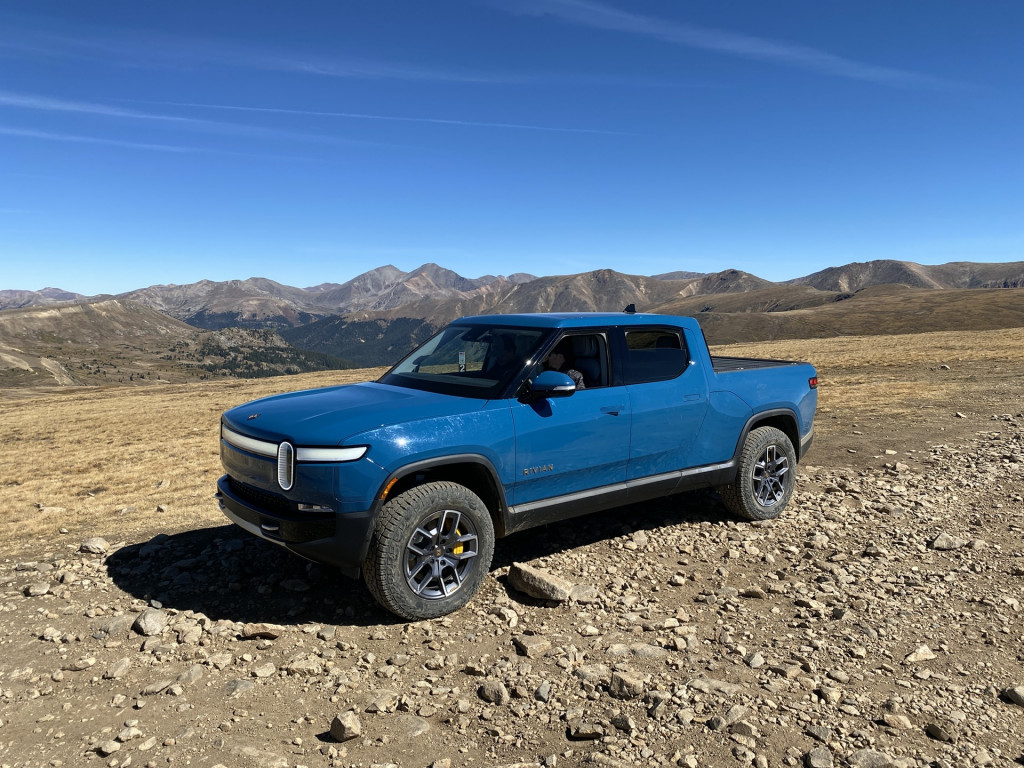
2022 Rivian R1T
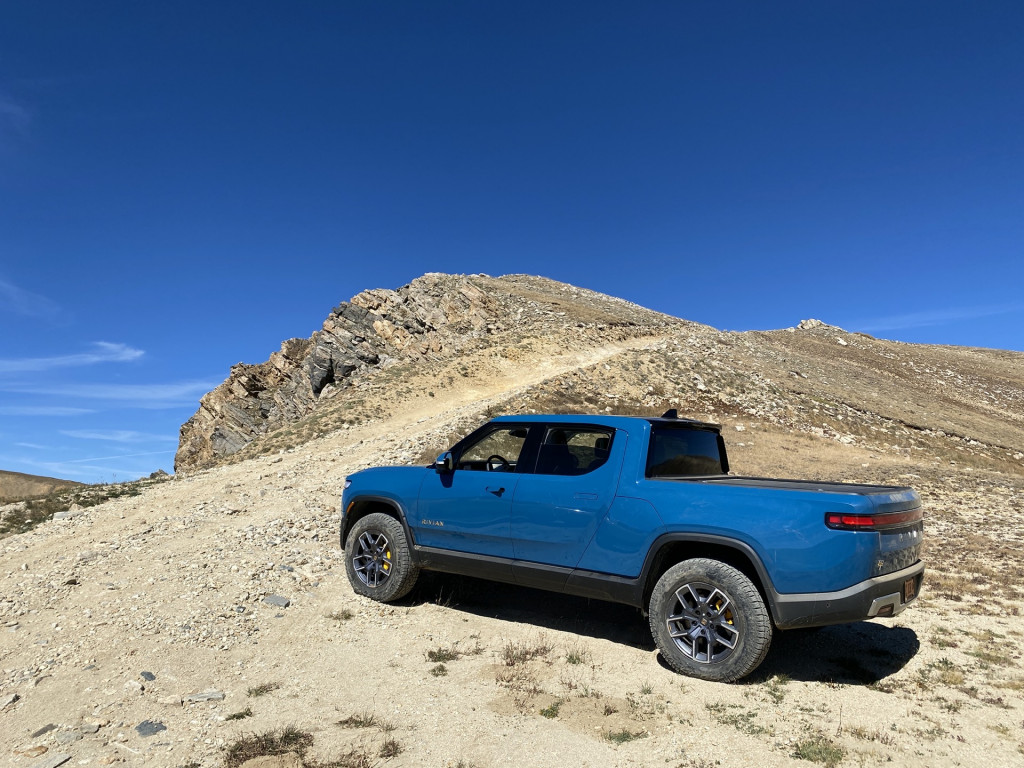
2022 Rivian R1T
All-Purpose
The R1T has five drive modes—All-Purpose, Sport, Offroad, Conserve, and Towing—with nearly 50 different drive settings for the ride height, adaptive dampers, regen braking, and stability control. The default All-Purpose, or auto mode, straddles the middle of all these settings, and can be overridden by the driving conditions or by the driver’s discretion.
Leave it alone and never bother with the 15.6-inch touchscreen that houses everything from the drive and suspension settings to the vent directions of the climate control. The lack of buttons and dials could frustrate some people migrating from traditional pickups or SUVs, but the clean dash design trimmed in ash wood makes for one of the warmest, most inviting cabins on the market.
But all the various settings beg to be played with for the adventuring sort targeted by Rivian. The adventuring starts with a massive 135-kwh battery pack that powers four independent motors with a drive unit on each axle, and two motors per drive unit controlling either half shaft. An EPA-rated range of 314 miles kicks off the three trims available at launch, but Rivian plans a larger battery pack due in 2022 that will provide a range of 400 miles for $10,000 more than the $67,500 base Explore edition.
2022 Rivian R1T
The motors work independently to make 415 hp and 413 lb-ft of torque for the front axle, and 420 hp and 495 lb-ft for the rear axle; together, the system churns out more than 800 hp and 900 lb-ft of torque. The quad motor set up enables torque vectoring at each corner of the truck to maximize grip on pavement and climb over off-road obstacles at low speeds.
The five different suspension heights and drive modes give the R1T a variability unmatched by other vehicles. Not every height is available with every drive mode, and most of them can go one notch above or below the standard ground clearance of 11.5 inches. The air suspension travels 6.5 inches, topping out at 14.4 inches in Offroad mode, and bottoming at 7.9 inches when parked.
My tester was a Launch Edition model trimmed out similarly to the Adventure trim that costs $73,000. It had the Off-road package that added front tow hooks, a reinforced underbody shield, and 20-inch wheels wrapped in 34-inch Pirelli Scorpion all-terrain tires to bring the price to $76,800 before EV incentives. Without the package, the R1T comes with 21-inch wheels with 33-inch Pirelli all-season tires, though 22-inch wheels with Pirelli performance tires are an option.
Even with the off-road tires, the R1T twisted through hairpin turns with agility and composure, clambered up deeply rutted rock trails, accelerated quicker than most sports cars, and did it all in near silence. Sport mode only made it better.
2022 Rivian R1T
Sport
Rivian claims a 0-60 mph time of 3.0 seconds, and I have every reason to believe it. Yet, the truck didn’t throw me back in my seat or hug corners like an electric performance sedan. As much as Rivian defies physics with the R1T, it can’t overcome all the limitations of its height and curb weight, estimated to be a whopping 6,900 lb, similar to many heavy duty pickup trucks. But no pickup, from the Ford F-150 Raptor to the Ram TRX to anything by Hennessey, has this kind of pick up.
Even Einstein would marvel at how well the R1T accelerates and handles. A big reason for this, perhaps more so than the multitude of suspension and ride quality settings, is that its 135-kwh battery pack of 7,776 small 2170-format Samsung SDI cells sits at the bottom of the truck between the axles for a relatively low center of gravity.
Above 50 mph, the suspension automatically lowers to 10.1 inches for better aero and efficiency, and that is also the standard ride height for Sport mode. The closest the R1T gets to the road while driving is 9.5 inches in Sport mode.
Sport mode utilizes more front axle torque and adjusts the damper setting from Soft to Stiffer that, along with the lowered ride height, lets it better hug the road.
That doesn’t mean it’s the optimal setting. For straight-line driving, the Stiffer damping setting and stability control set to “On” might be best to harness all that instantaneous linear torque. But more varied terrain, like when rotating the truck, requires a different kind of modulation.
Max Koff, Rivian’s Director of Vehicle Dynamics, said that situation deserved “Soft” damping, “Max” regen braking, and “Reduced” stability control; he called it “the chef’s kiss of engineering sweet spots.” With the rear of the truck sliding out and Koff snapping it back in line, all while talking calmly about the R1T’s dynamics as if there weren’t a 500-foot death plunge beyond a wheel, it all made perfect sense.
2022 Rivian R1T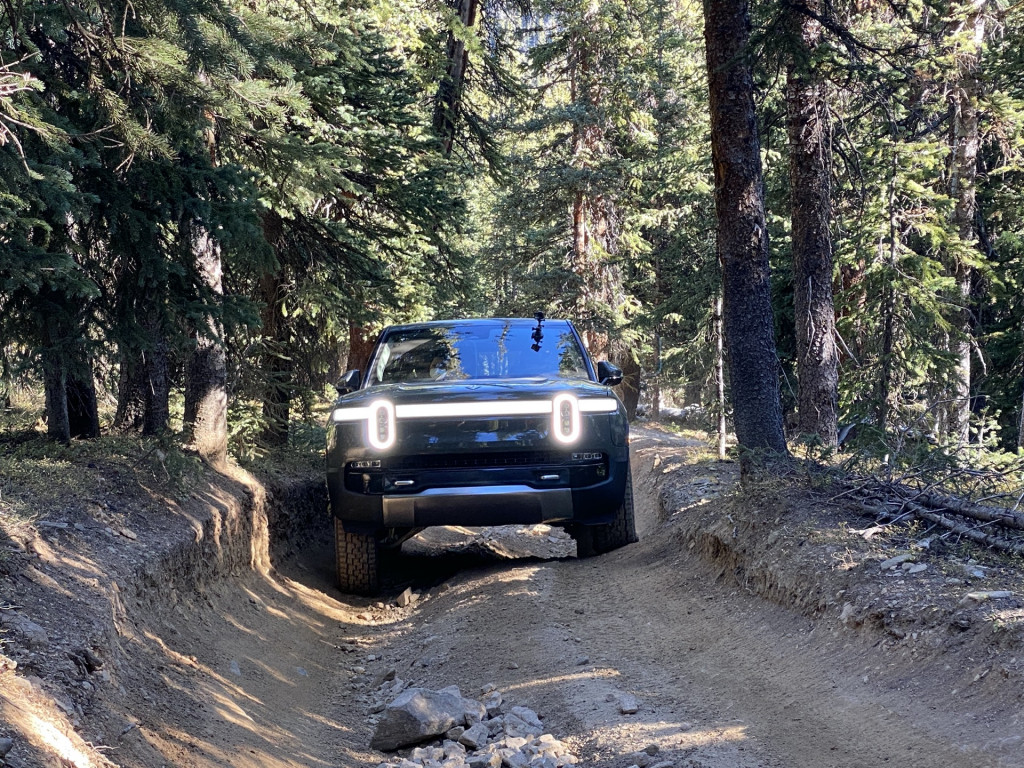
Climbing up and down the same grade that Koff demonstrated allowed me to play with the settings and switch the damping to “Stiffer.” It jounced more on unsteady pavement, but was far from harsh. Passing slower vehicles up slope, which seemed to be every vehicle, came easy with the instantaneous torque of the R1T.
The various settings allow for far more modulation than you might ever use, but it’s there if you want it. One of the few drive systems to remain fixed is the electronically assisted steering. The suspension changes might make it seem like it adds steering heft, but the ratio remains the same. On-center feel is good, and the steering response is never too loose or too firm, though drivers used to performance cars might want more resistance and road feel.
The key reason the R1T can handle sharp turns with such agility is because Rivian employs a hydraulic control system instead of anti-roll bars that are linked front to rear and side to side to stiffen the chassis. Like what McLaren uses on its supercars, Rivian runs two fluid lines between the front wheels, then a T line runs to the back and connects the rear wheels. When you turn hard to the right and the body rolls to the left, the fluid limits the compression on the left side to even it out and balance lateral motion. In essence, the two lines at either axle fight each other for dominance. The system enhances on-road performance and off-road comfort, and lets the air suspension, double front wishbones, and adaptive dampers handle the vertical load.
2022 Rivian R1T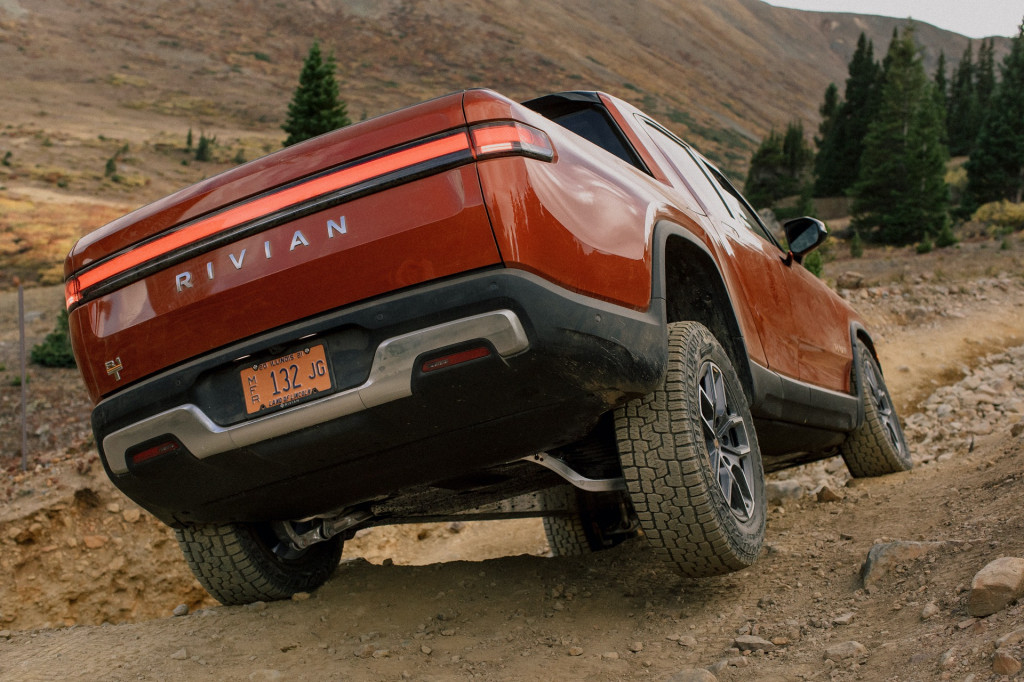
Offroad
The Offroad setting is the most complex of the five main drive modes, with four sub-modes that automatically adjust the stability control and suspension settings in Auto, Rock Crawl, Rally, and Drift modes. For all the composure and blistering acceleration on pavement, the off-road capabilities of the R1T are as impressive.
For off-road intenders, whether its old mining roads or slickrock in Moab, consider the Off-Road package. Instead of 21- or 22-inch wheels, it comes with 20-inch wheels wrapped in 34-inch Pirelli Scorpion 275/65/R20 all-terrain tires. (Pro tip: To change a tire, set the suspension to max height in Offroad mode, then find Tire Change mode in the touchscreen under the Settings wheel. Then crank the jack.) The underbody shield that protects the battery pack gets reinforced with a layer of steel, carbon fiber, and aluminum honeycomb for energy absorption. Rivian said the off-road testing included dropping the vehicle 15 inches on a pointed rock with no battery degradation, and Koff assured us of many hours of bashing.
That’s one of the compelling traits about Rivian: Like founder and CEO R.J. Scaringe, Koff and the other engineers I spoke with are rabid car enthusiasts with ongoing projects in their personal garages worthy of their peers’ admiration or mockery, and oftentimes both. The collaborative, collegial atmosphere produced a truck engineered with benchmarks targeting the Porsche Cayenne Turbo on the road, the comfort and ride quality of a Land Rover Discovery, and the off-road chops of a Jeep Wrangler Rubicon and Ford F-150 Raptor.
In Auto, the low center of gravity, wide track, and individual wheel travel makes for balanced clambering even at a lateral pitch of about 20 degrees in our testing. On a chilly 27-degree morning at an elevation above 10,000 feet, a front wheel slipped on ice and rock, but I applied more throttle so the three other wheels pushed the truck through. Instead of a locker, the four-wheel-drive system limits torque from the motor on the slipping wheel. In Drift mode, the system allows for more wheel slip, but in Rock Crawl mode, there’s much quicker modulation of torque between the motors. I didn’t have the wide open spaces to test Drift mode. Next time.
2022 Rivian R1T
The geometry helps, with an approach angle of 34.0 degrees, a departure angle of 29.3 degrees, and a breakover of 25.7 degrees. Those angles split the difference between the Wrangler Rubicon four-door’s 44/37/22.6-degree approach/departure/breakover angles and the Ford F-150 Raptor’s 33.1/24.9/24.4 angles with 37-inch tires.
Neither of those benchmarks can match the ground clearance provided by the R1T’s air suspension, but that’s not the only competitive advantage.
There’s no pumpkin, no giant rear differential to scrape, and no fuel lines or transmission cases to cover, so instead of aiming a wheel for a rock to crawl over, you can straddle obstacles and easily clear them with 14.9 inches of clearance (it’s higher due to the larger 34-inch tires with the Off-road package). Cameras at the front and rear, as well as on the side mirrors, project back and forth to give visuals for where your eyes can’t reach. The most remarkable thing is how quiet it is, with the traditional grinding of lockers and thrumming of the engine replaced by the crush of rock and the burbling of a creek. It makes for a serene off-roading experience that made me feel more like a part of nature than an outsider trying to conquer it.
Descending a slope or pausing while climbing in Rock Crawl is also different than in traditional off-roaders. There’s no “Hold” so two-foot driving is needed to hold the brake on a slope and gently accelerate so you don’t roll back into the R1T behind you, say. For now, there’s no hill descent control, but the “Max” regen braking setting fills that void, except when the wheels slip and allow the truck to shuttle forward. That mode requires more attention, as it should. An actual hill-descent control function would be welcome.
2022 Rivian R1T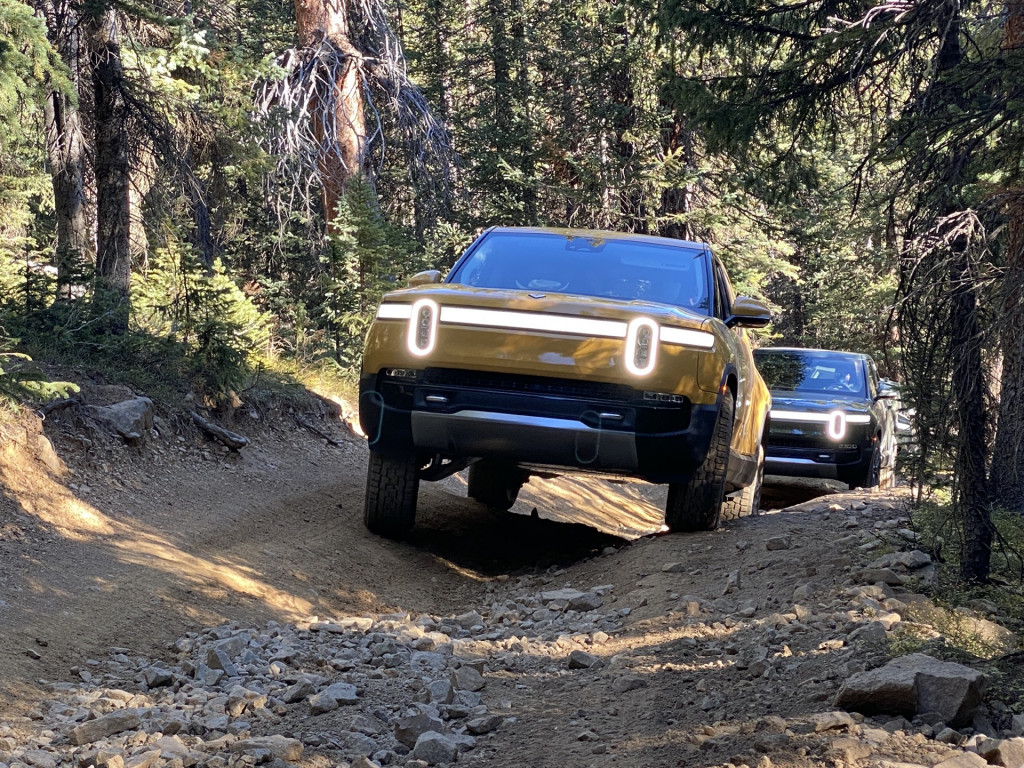
We climbed to 12,000-feet up a narrow rutted path flanked by fir trees at one point, then deep mud walls at another. At 81.8 inches wide with the mirrors folded, the R1T is a couple inches narrower than the Ford F-150 crew cab (83.6-inch width with mirrors folded), but it's more than a foot shorter in length than a F-150 crew cab with the shortest bed. That makes it more maneuverable than a full-size truck but not as agile as a Wrangler Rubicon. The off-road world is full of tradeoffs, too.
The trail was dry, even with snow lurking in the shade of boulders and fallen aspens. In the few water crossings I made in the R1T, the water only cleaned the tires, but Rivian says it can wade more than 36 inches.
Up above the tree line, riding along the spine of a Rocky peak or three, the R1T never hesitated or needed to pause to suck in air, unlike its driver. The 60-mile loop never threatened the roughly 180-mile range we started off with. After our group stopped in a valley for lunch made on one of the camp stoves that fits in the cargo tunnel of the R1T, we filled up the tires from the standard on-board air compressor and headed back downslope on pavement. Up and down Loveland pass we went, testing the Sport mode, and finished at base camp with slightly less than 100 miles of range left. I didn’t track the exact distance on the odometer, but we drove from dawn to dusk with plenty of remaining range.
2022 Rivian R1T
Conserve
The permanent four-wheel-drive system becomes less permanent in Conserve mode. The suspension lowers to 9.5 inches, the climate control reduces its output, and the rear axle disconnects, making it a two-motor drive unit. The front-wheel-drive mode has softer pedal mapping, and the lowered, stiffer suspension makes for a firmer ride.
An energy meter in the left side of the cluster can be left on to gauge efficiency, and the range remains on display in the bottom right corner of the cluster. Usage can also be tracked in more detail through the touchscreen. The difference between Max, High, and Standard regen is not that pronounced, and learning how to modulate the accelerator for one-pedal driving for smooth stops into stoplights comes relatively easy in Max mode.
The 135-kwh battery pack uses a gas equivalent of 70 mpg combined. Its heavy weight and truck-like aero makes it less efficient than most electric vehicles available now. it takes 48 kwh of energy to go 100 miles. An Audi E-Tron SUV with AWD uses 43 kw per 100 miles, while a Tesla Model S Long Range with AWD uses only 28 kwh per 100 miles.
The driver’s side front charge port follows J1772 and CCS standards, with DC fast-charging at more than 200 kw, enabling about 140 miles of charge in 20 minutes. Rivian is building out its DC fast-charging Adventure Network with 600 sites planned nationally and in Canada by the end of 2023. Level 2 Waypoints at 11.5 kw charge up to 25 miles per hour, and Waypoints are expected to exceed 10,000 chargers by 2024.

2022 Rivian R1T

2022 Rivian R1T
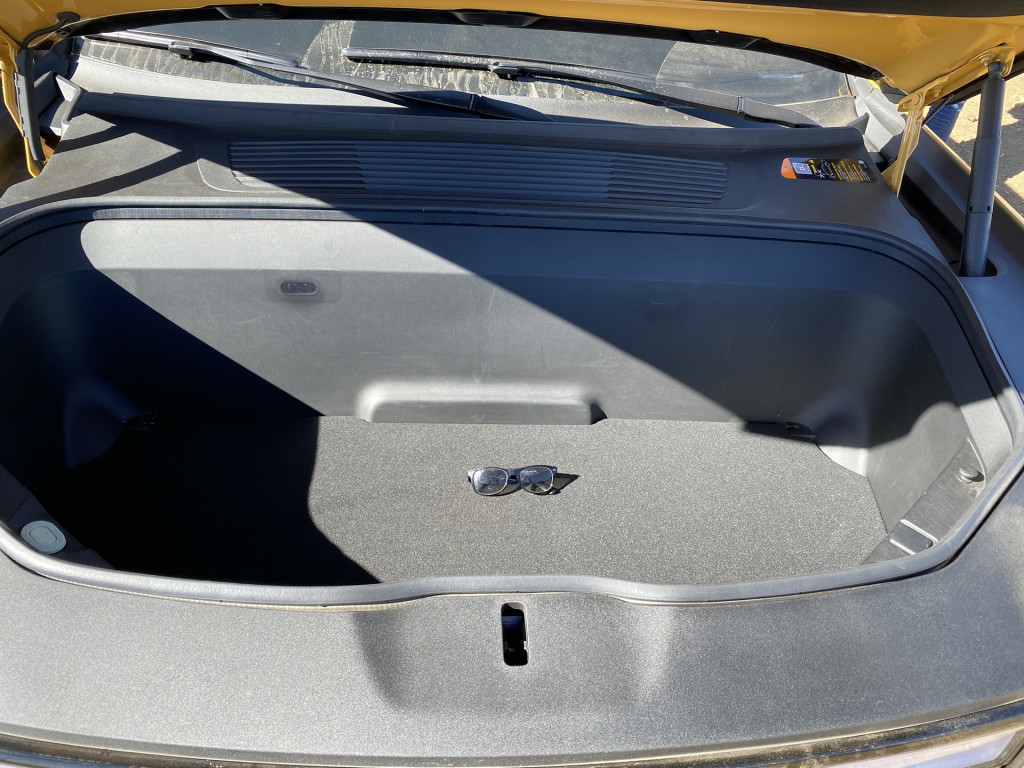
2022 Rivian R1T
Towing and cargo
Towing capacity maxes out at 11,000 lb, but we did not test Towing mode. The air suspension automatically levels the ride height when towing, and the various drive settings automatically adjust to suit the load.
Instead, we tested the many cool cargo spaces in the R1T. The 68 cubic feet of storage space is spread around the truck. The bed is on the small side. It’s only 54 inches long, but lowering the power tailgate expands the length to 83.8 inches. It’s 51.1 inches wide, so it can haul sheets of plywood with the tailgate down and straps secured to the two tie downs or eight available clamps.
With the gate up, the bed carries 29.2 cubic feet of cargo, and the R1T has a max payload of 1,760 lb. The side walls are short enough to reach over the side and pull out gear, and you can also lower the ride height for easier reach. It has roof lights and LED bars on the sides, a power tailgate, an available power tonneau cover, two 120-volt outlets, and standard air compressor with a max output of 150 psi. An optional full-size spare fits in the underfloor storage, but since it has a drain plug it can be used as a cooler or for wet storage, same as up front in the underfloor part of the frunk. The front trunk holds up to 11 cubic feet of cargo.

2022 Rivian R1T

2022 Rivian R1T
The coolest storage element is what Rivian calls a gear tunnel situated between the cab and the bed. Two bottom-hinged power doors open up to 90 degrees from either side of the truck, with small storage cubbies in them big enough to hold the air compressor hose. They also double as seats or platforms to stand on and survey the terrain, secure items in the bed, or attach the crossbars for the rooftop tent; the cargo doors each hold up to 250 lb. The tunnel, which can also be accessed through a pass-through in the rear seats (as long as the truck is in Park), can hold up to 11.6 cubic feet of gear that weighs up to 300 lb; we fit two carry-ons and two backpacks. A power-sliding shelf for the tunnel is optional, and it plugs into a 110-volt outlet in the tunnel, for accessories such as the Camp Stove.
The R1T is the future of lifestyle pickup trucks. There’s no glovebox, and the touchscreen can be problematic when trying to access off-road functions or climate controls while in motion, but there is not another vehicle on the market with this breadth of capability while making zero tailpipe emissions. That’s the welcome sound of silence.
Rivian provided airfare, lodging, and supplemental oxygen for Motor Authority to bring you this firsthand report.



